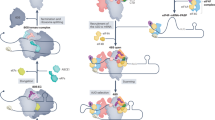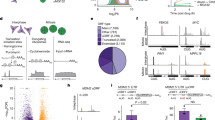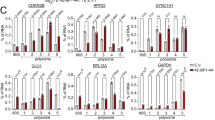Abstract
EUKARYOTIC cellular mRNAs have a 5' cap structure (m7 GpppX) that facilitates binding to ribosomes and is required for efficient translation1–3. A specific initiation factor, eIF-4F, mediates the function of the cap4–6 and consists of three subunits7–10, one of which, eIF-4E, binds the cap. This subunit is present in limiting amounts in the cell11–13, and is thought to be regulated by phosphorylation12–16: decreased phosphorylation of eIF-4E following various treatments correlates with a decrease in cellular translation rate. These observations suggest that eIF-4E lies on the mitogenic signal transduction pathway, and we reasoned that overexpression of eIF-4E might profoundly affect cellular growth properties. We report here that overexpression of eIF-4E in NIH 3T3 and Rat 2 fibroblasts causes their tumorigenic transformation as determined by three criteria: formation of transformed foci on a monolayer of cells; anchorage-independent growth; and tumour formation in nude mice.
This is a preview of subscription content, access via your institution
Access options
Subscribe to this journal
Receive 51 print issues and online access
We are sorry, but there is no personal subscription option available for your country.
Buy this article
- Purchase on SpringerLink
- Instant access to full article PDF
Prices may be subject to local taxes which are calculated during checkout
Similar content being viewed by others
References
Shatkin, A. J. Cell 9, 645–653 (1976).
Banerjee, A. K. Microbiol. Rev. 44, 175–207 (1980).
Sonenberg, N. Prog. Nucleic Acid Res. molec. Biol. 35, 173–207 (1988).
Tahara S. M., Morgan, M. A. & Shatkin A. J. J. biol. Chem. 256, 7691–7694 (1981).
Grifo, J. et al. J. Biol. Chem. 258, 5804–5810 (1983).
Edery, I. et al. J. Biol. Chem. 258, 11398–11403 (1983).
Sonenberg, N., Morgan, M. A., Merrick, W. C. & Shatkin, A. J. Proc. natn. Acad. Sci. U.S.A. 75, 4843–4847 (1978).
Abramson, R. D. et al. J. Biol. Chem. 262, 3826–3832 (1987).
Ray, B. K. et al. J. Biol. Chem. 260, 7651–7658 (1985).
Rozen, F. et al. Molec. cell. Biol. 10, 1134–1144 (1990).
Hiremath, L. S., Webb, N. R. & Rhoads, R. E. J. biol. Chem. 260, 7843–7849 (1985).
Duncan, R., Milburn, S. C. & Hershey, J. W. B. J. biol. Chem. 262, 380–388 (1987).
Rhoads, R. E. Trends Biochem. Sci. 13, 52–56 (1988).
Bonneau, A-M. & Sonenberg, N. J. biol. Chem. 262, 11134–11139 (1987).
Marino, M. W., Pfeffer, L. M., Guidon, P. T. Jr & Donner, D. B. Proc. natn. Acad. Sci. U.S.A. 86, 8417–8421 (1989).
Morley, S. J. & Traugh, J. A. J. biol. Chem. 264, 2401–2404 (1989).
Kirschmeier, P. T. et al. DNA 7, 219–225 (1988).
Rychlik, W., Russ, M. A. & Rhoads, R. E. J. biol. Chem. 262, 10434–10437 (1987).
Joshi-Barve, S., Rychlik, W. & Rhoads, R. E. J. biol. Chem. 265, 2979–2983 (1990).
Freedman, V. H. & Shin, S. Cell 3, 355–359 (1974).
Amrein, K. E. & Sefton, B. M. Proc. natn. Acad. Sci. U.S.A. 85, 4247–4251 (1988).
Brenner, C. et al. Molec. cell. Biol. 8, 3556–3559 (1988).
Altmann, M. & Trachsel, H. Nucleic Acids Res. 17, 5923–5931 (1989).
Rao, C. D., Pech, M., Robbins, K. C. & Aaronson, S. A. Molec. cell. Biol. 8, 284–292 (1988).
Marth, J. D. et al. Nature 332, 171–173 (1988).
Godeau, F., Persson, H., Grey, H. E. & Pardee, A. B. EMBO J. 5, 3571–3577 (1986).
Darveau, A., Pelletier, J. & Sonenberg, N. Proc. natn. Acad. Sci. U.S.A. 82, 2315–2319 (1985).
Ratner, L., Thielan, B. & Collins, T. Nucleic Acids Res. 15, 6017–6036 (1987).
Altmann, M., Miller, P. P., Pelletier, J., Sonenberg, N. & Trachsel, H. J. biol. Chem. 264, 12145–12147 (1989).
Zoller, M. J. & Smith, M. Nucleic Acids Res. 10, 6487–6500 (1982).
Ausubel, F. M. et al. in Current Protocols in Molecular Biology (Wiley, New York, 1987).
Maniatis, T., Fritsch, E. F. & Sambrook, J. Molecular Cloning (Cold Spring Harbor, New York, 1982).
Author information
Authors and Affiliations
Rights and permissions
About this article
Cite this article
Lazaris-Karatzas, A., Montine, K. & Sonenberg, N. Malignant transformation by a eukaryotic initiation factor subunit that binds to mRNA 5' cap. Nature 345, 544–547 (1990). https://doi.org/10.1038/345544a0
Received:
Accepted:
Issue Date:
DOI: https://doi.org/10.1038/345544a0
This article is cited by
-
Hydrogel armed with Bmp2 mRNA-enriched exosomes enhances bone regeneration
Journal of Nanobiotechnology (2023)
-
N2 modified cap analogues as translation inhibitors and substrates for preparation of therapeutic mRNA
European Biophysics Journal (2023)
-
Translational control of stem cell function
Nature Reviews Molecular Cell Biology (2021)
-
Inhibition of translation initiation factor eIF4a inactivates heat shock factor 1 (HSF1) and exerts anti-leukemia activity in AML
Leukemia (2021)
-
Evaluation of carboxyfluorescein-labeled 7-methylguanine nucleotides as probes for studying cap-binding proteins by fluorescence anisotropy
Scientific Reports (2021)



